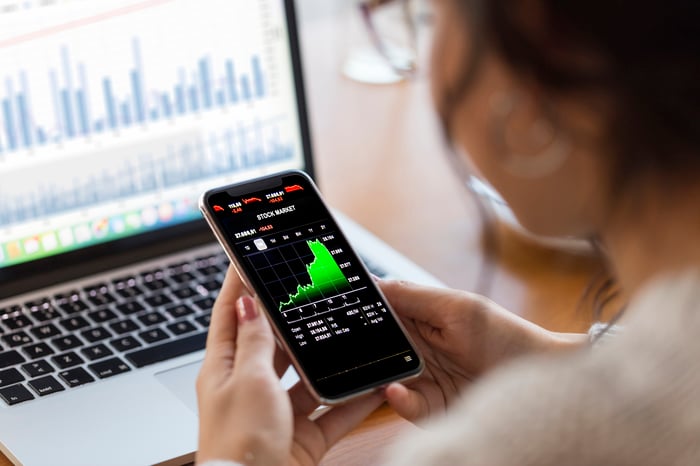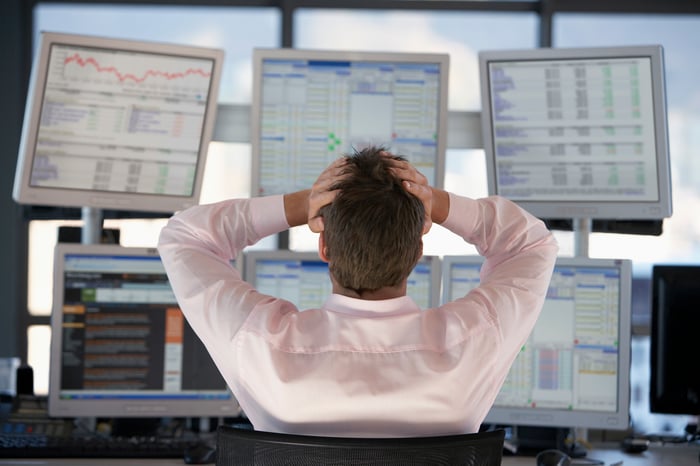For much of the past year, Wall Street has been turning heads and making history. In the wake of the coronavirus disease 2019 (COVID-19) pandemic, the benchmark S&P 500 (^GSPC 0.15%) lost more than a third of its value in under five weeks. It then took less than five months for the widely followed index to recapture new highs.
But it's not just record-breaking broader market moves that have raised eyebrows. Over the past two weeks, we've watched retail investors clash with the so-called big money like never before.

Image source: Getty Images.
Retail investors take on Wall Street's big money
In simple terms, retail investors who are part of the "WallStreetBets" chatroom on community sharing platform Reddit have decided to ban together to buy shares and out-of-the-money call options on stocks with high levels of short interest.
Short-sellers are investors who want the price of a stock or security to go down. For short-sellers, gains are capped at 100% since a stock can't go any lower than $0. However, losses are unlimited given that there's no ceiling on the price of a security. What retail investors are effectively doing is rocketing the share price of heavily short-sold stocks higher and creating a short squeeze -- i.e., a scenario where short-sellers' losses become steep enough that they all head for the exit. Since short-sellers are required to buy shares of the stock they're short to cover their position, this only adds fuel to the upside move.
Furthermore, it's important to understand that most short-selling is done by hedge funds and institutional money managers, not retail investors. Therefore, an orchestrated effort by the WallStreetBets crowd is specifically targeting these big-money investors.

Image source: Getty Images.
The gamification of Wall Street takes shape
In late January, we witnessed this "Reddit raid" result in violent volatility and significant upside for video game and accessories retailer GameStop (GME 3.62%), movie theater chain AMC Entertainment (AMC -2.80%), and software company BlackBerry, to name a few companies.
But there's a reality to this volatility that retail investors must face. Specifically, that we're well beyond the point where these moves can be called short squeezes any longer.
Through the first month of the year, GameStop and AMC Entertainment rose by a respective 1,625% and 525%. Yet over the previous six trading sessions leading up to last weekend, GameStop and AMC saw approximately 756 million and 3.58 billion respective shares trade hands. That's more than enough liquidity for short-sellers to exit their positions if they wanted to. What we've predominantly been witnessing with these two front-and-center names is nothing short of day-trading and the gamification of the stock market.
What retail investors are bound to learn sooner or later is that if you try to game the market, you're eventually going to get played.

Image source: Getty Images.
History suggests retail investors are in for a world of hurt
Two years ago, three scholars in Brazil released their findings after examining how close to 20,000 new options and futures day-traders performed over time. The study noted that only 30% of the day-traders were profitable after one day of trading. By day 300, only 3% of day-traders remained profitable.
Furthermore, the longer someone day-traded, the more money they tended to lose. Over the long-term, only 1% of day-traders earned more than the Brazilian minimum wage. In other words, not only is it incredibly unlikely that timing the market will pay off, but day-traders failed to get better at dicing in and out the market over time.
In a separate study released in October 2017, five academics analyzed the performance of day-traders in Taiwan from 1992 to 2006. What stood out about this study was the breakdown by the authors of unprofitable versus profitable full-time day-traders between 1995 and 2006. Over this 12-year period, only 5% of traders were consistently profitable. By comparison, more than two-thirds of day-traders were consistently unprofitable, and by 2006 comprised nearly 80% of day-trading volume.

Image source: Getty Images.
As for a closer-to-home example, we can turn to a report published by J.P. Morgan Asset Management, "Staying Invested During Volatile Markets." This 2016 analysis of the broad-based S&P 500 had two key findings.
First, if you missed out on the S&P 500's 30 best single-session returns between Jan. 3, 1995 and Dec. 31, 2014, you'd have a negative return. For context, the S&P 500 averaged a 9.9% annualized return over this 20-year period, equating to an aggregate gain of 555%.
Secondly, around 60% of the S&P 500's biggest single-session gains over this two-decade span occurred within a few weeks of its worst single-session performances. In simpler terms, if you ran for the exit because you felt a correction coming, you potentially missed out on a big rebound.
The point of all of these stories is simple: If you treat the stock market as a get-rich-quick scheme and attempt to time the market, the odds are very much against you succeeding. We've witnessed various pricing abnormalities come and go over many decades, and one of the few investing constants is that operating earnings growth, not emotions, are what drive sustainable price movements in equities. It may not be today, tomorrow, or even next week, but the day-traders and speculators whipsawing GameStop, AMC, and a host of other names are eventually going to get played.





